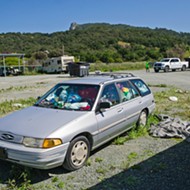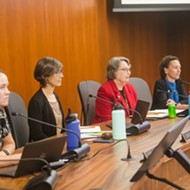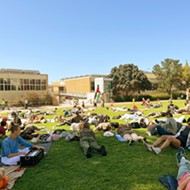Return to limbo: Georgia Brown Elementary's status remains unclear as Paso's school board seeks answers in the face of public response and state rulings
By Adrian Vincent Rosas[{
"name": "Newsletter Promo",
"id": "NewsletterPromo",
"class": "inlineCenter",
"insertPoint": "4",
"component": "15264767",
"requiredCountToDisplay": "0"
},{
"name": "Ad - Medium Rectangle CC01 - 300x250",
"id": "AdMediumRectangleCC01300x250",
"class": "inlineCenter",
"insertPoint": "8",
"component": "2963441",
"requiredCountToDisplay": "12"
},{
"name": "Ad - Medium Rectangle LC01 - 300x250",
"id": "AdMediumRectangleCC01300x250",
"class": "inlineCenter",
"insertPoint": "18",
"component": "2963441",
"requiredCountToDisplay": "22"
},{
"name": "Ad - Medium Rectangle LC09 - 300x250",
"id": "AdMediumRectangleLC09300x250",
"class": "inlineCenter",
"insertPoint": "28",
"component": "3252660",
"requiredCountToDisplay": "32"
}]
Georgia Brown Elementary School's long-awaited renovations halted before they could begin after an anomalous geological feature was discovered under the campus in May—pushing students and teachers back toward uncertainty.
Paso Robles Joint Unified School District Superintendent Curt Dubost told New Times that the school's state of limbo is likely to continue far into the future.
"The full-scale renovations we had initially planned are almost entirely out of the picture due to the state's ruling," Dubost said. "We [were] planning very limited touch-ups to the campus because [at this time] we expect it to be used in some capacity as a school at the very least."
But he also made it clear that the board wouldn't be taking any sort of immediate vote regarding campus renovations—because it couldn't.
"We have no plan at this time to move forward with anything from what we know," Dubost said. "The only thing the [the district and board] can do is provide direction on what the next steps are now that the information has been put out and the public has voiced their concern."
After finally deciding the fate of Georgia Brown Elementary School last year, the Paso Robles school district discovered the anomaly under the school that's put its planned renovation in jeopardy. The geologic feature could be seismic—there's about a 50 percent chance of it, district officials said. The Division of the State Architect will require a deeper investigation to find out for sure before any shovels can hit the ground.
The discovery occurred as part of pre-construction activities, and it will continue to delay the district's plans to renovate Georgia Brown and turn it into a smaller neighborhood school to later house Glen Speck Elementary.
After taking public opinion on the matter on Aug. 7, the district's school board voted unanimously on Aug. 8 to bring back several topics for a proper vote at its next meeting, hoping for more clarity for themselves and the community.
"Can we do anything and should our students be there right now?" board President Nathan Williams asked at the meeting. "If we can do things, to what extent can we do them?"
These potential actions include establishing more studies on the capacity of other campuses to house the students from Georgia Brown, demographic studies on students who would be affected by the closure of the campus, and establishing a third-party study to see what the next steps might look like.
Board members unanimously voted to seek immediate clarification and details from the state about whether the school could be occupied by students this upcoming year, as classes start in mid-August.
"If we can't even do modifications, that's a whole new risk liability," Williams said at the meeting. "We need to know what we can or cannot do, and we need to get that information immediately."
Fellow board members agreed with his concerns over the vagueness of the state ruling, calling into question whether or not the school was even safe for occupancy—and if it wasn't, why it wouldn't tell the district that.
"[The state] is trying to force the board to decide because they cannot morally admit the building is safe," board member Kenney Enney said at the meeting. "I don't think it's fair to tell the community, 'You have to go back to the building,' because at that point you are effectively being boxed in."
Superintendent Dubost assured the board and the public that he had been told by the Division of the State Architect that the campus was still safe for occupancy.
"We have had heated discussions with the state, and they said it was safe for this year but wouldn't guarantee beyond it," he said at the meeting.
He added that district staff had been in direct contact with state Sen. John Laird's office to see if there was any appeal process they could make to counter the report about the anomaly, but they were informed that there was none.
"I have turned over every stone that I could to try and get more information," Dubost told the board. "All of these decisions are not ours to make, they are the state's."
Regardless of who the decision-makers end up being, board members did acknowledge on Aug. 7 and 8 that the importance of the campus and the program it housed was undeniable.
The campus has long served as the host of the district's Dual Immersion Program, which aims to provide a fully bilingual learning environment for students.
Public comment from myriad concerned parents and residents at both echoed a concern and long-standing feeling in the community that the school had been ignored for far too long.
"I've been through the whole system; it is very, very important that we continue this program, and even more important that you keep the program there," Paso resident Fransisco Ramirez said via public comment on Aug. 8. "Let's figure out what we can do because this program has a real impact."
As it journeys on to the next steps of an increasingly long process, the board intends to take every perspective into account.
"That's why we created the initial [Aug. 7] forum for those who want to speak to be heard and for us to show that we are all listening," Williams told New Times. "[We] want to show that we are being as diligent, responsible, and open as we can with this process ... [and have] slowed things down so we can be as careful with this new reality as possible."
Board member Jim Cogan told New Times that the issue has become far more complicated than anyone in the district initially anticipated. He's hopeful that the board can show that it's giving the process as much thought and energy as possible.
"This is a very difficult situation, as everyone wants to offer an easy answer, In every scenario, people are going to be concerned, or at least upset with the result," Cogan said. "It is incumbent on us to ensure any solution we come to is done in the open—no decision should be made behind closed doors."
Ultimately, the district is grappling with one question: How can it make sure its campuses are benefiting those who matter the most?
"My guiding light—and what I imagine is the rest of the board's guiding lighting—is what is best for our students long-term," Cogan said. "Whatever transition we go through is going to be disruptive, so is the best solution so that five years from now students will be in the best learning environment they can be in?" Δ
Reach Staff Writer Adrian Vincent Rosas at [email protected].
Latest in News
Comments
Showing 1-1 of 1
Readers also liked…
-

Coast Unified teachers upset over new position's salary and qualifications
Oct 20, 2022 -

SLO police identify alleged driver who hit and killed couple
Dec 22, 2022 -

When the levee breaks: Oceano residents, county officials walk a tightrope of regulations to manage Arroyo Grande Creek, which some say led to the levee's failure in January
May 18, 2023












